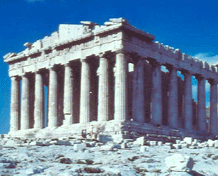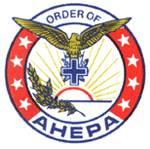 International Panel Discusses Reunification of the Parthenon Marbles By Anthi Poulos, Founder/Chair, The Committee on the Parthenon |
||||
There exists no more appropriate symbol of the necessity for unity than the Parthenon itself. Only when the Greeks reconciled and balanced their love and dedication to liberty with the need for unity were they successful in repelling the invading Persians. It was in recognition of this successful battle by the free Greeks to regain their liberty that the building of the Parthenon was undertaken and dedicated. In addition to being the international symbol of culture and democracy, the Parthenon itself stands as a testament to that unity of purpose and cooperation which won the battle against the Persians. Those attending the Conference heard prominent, internationally-recognized authorities speak about the Parthenon, the story of the Marbles, and the International Campaign for the Reunification of the Parthenon Marbles. The panelists were experts with scholarly and professional backgrounds in art history, archeology, international law, and museology. The Conference itself presented analyses of the factors to be considered, explored the state and international legal dimensions of this critical issue, and analyzed approaches to be considered in these deliberations on the future of the Parthenon Marbles. I had the distinct honor to be the Moderator and Presenter of the Conference. Supreme President Andrew T. Banis who last fall, following a meeting of AHEPA International, decided to undertake as a lead project the Reunification of the Parthenon Marbles, presented introductory remarks. AHEPA International will work in conjunction with the Committee on the Parthenon in the United States in this effort.
Ms. Elena Korka, Archeologist, The Hellenic Ministry of Culture, discussed the Impact of the Transportation of the Parthenon Marbles to England and gave a vivid, electronic exhibit of the segments combining the parts in the British Museum with those remaining at the Acropolis to demonstrate visually how the reunification would restore the images and artistic and aesthetic quality of the sculptures. The removal and transportation of the Parthenon Marbles are issues of great international interest to archeologists and international legal scholars. The Parthenon Marbles are the sections of the Parthenon temple, frieze and sculptures removed by Lord Elgin (then British emissary to the occupying Ottoman Empire) from the Parthenon Temple in Athens to London in 1801-1816, under circumstances of debatable legality. Ever since Greek liberation from the Ottoman Empire, the Greek government, Philhellenes, and believers in the right of cultural heritage all over the world, have campaigned for the Reunification of the Parthenon Marbles.
Attorney Mr. Jeffrey G. Schneider introduced Dean David Rudenstine of the Cardozo Law School. Schneider served on the team of legal scholars who drafted the testimony submitted to the House of Commons Committee on Culture Media and Sport in their hearings in 2000 on the Parthenon Marbles. The testimony was accepted and published in the official record of the Committee Inquiry. Dean David Rudenstine is widely published on the issue of the Parthenon Marbles and is a recognized expert on the validity of the documents on which the House of Commons in 1816 relied in accepting the legitimacy of Lord Elgin's removal of the Marbles before they purchased the collection from him and donated it to the British Museum which had just been founded in London at that time. Dean Rudenstine gave a very interesting legal analysis and evidentiary study entitled Legal Issues of the Removal of the Parthenon Sculptures by Lord Elgin. The legal issues were further explored by Florida attorney Michael J. Reppas, LL.M., who has published articles on the international legal issues present in the case of the Parthenon Marbles. He spoke on International Law and the Removal of the Parthenon Marbles. Reppas was introduced by Ms. Theresa Papademetriou, LL.M., Senior Legal Specialist, the European Union, Greece and Cyprus. Ms. Papademetriou has authored and edited several research articles on the international legal issues of cultural property and cultural heritage.
The culmination of the discussion on the Reunification of the Parthenon Marbles was the presentation by Professor Dimitrios Pandermalis, the University of Thessaloniki and President, The Organization for the Construction of the new Acropolis Museum. His speech included a vivid slide presentation and a briefing on the current plans to build The New Acropolis Museum to House the Parthenon Marbles. Professor Pandermalis was introduced by Mr. Nicholas Karakas, The Karakas Family Foundation and the University of Missouri. Karakas is the driving force behind the establishment of the new Greek Chair at the University of Missouri and a major supporter of the Committee on the Parthenon. Karakas discussed the importance of having a museologist and archeologist of the caliber of Professor Pandermalis to lead this critical project for the design and construction of the new museum which will one day house the Parthenon Marbles once they are reunited at the Acropolis. Professor Pandermalis answered all questions regardng how the Marbles would be ideally exhibited in the new museum. The final portion of the Conference centered on the International Perspectives on the Reunification of the Parthenon Marbles. The audience was informed about the history and development of the international campaign for the reunification of the Parthenon Marbles in Australia and New Zealand, beginning with the founding of the first international committee in Australia in 1981, by the founder of the latest committee in New Zealand, Ahepan, Emanuel J. Comino. He discussed the history of his dedication to the Reunification of the Marbles, beginning with his work with then Minister of Culture, Melina Mercouri, up to the present day, with the latest addition of the Canadian Committee, as well as others. Representing Canada, the Honorable Steve Ashton, of the Manitoba Legislature, shared the history of the development of the Committee in Canada and all its many activities to raise the consciousness of Canadians in the importance of this issue. Ashton shared his own impressions of the international historical importance of the Parthenon and the Reunification of the Parthenon Marbles. Mr. Gregory Gross, Chief of Staff to U.S. Sen. Peter Fitzgerald (R-IL), spoke about activities in the Congress regarding the effort for the Reunification of the Parthenon Marbles. He discussed the current legislation and encouraged all Ahepans to become involved in promoting interest among their own Congressional Representatives. Specifically, he urged support for the legislation introduced by Sen. Fitzgerald with Congressman Donald M. Payne (D-10-NJ), expressing Congressional interest to the British Parliament that the Parthenon Marbles should be reunited with the Parthenon and, if possible, in time for the 2004 Olympics. In 1999, Congressman Payne personally briefed President Clinton in great detail prior to the President's trip to Greece with documents prepared by the Committee. In Greece that year, President Clinton stated his unequivocal support for the reunification of the Parthenon Marbles, and endorsed the international and U.S. view that the Marbles should be reunited with the Parthenon temple. It appears that President Clinton's declaration has begun a new glorious momentum on behalf of the Parliament. Publication of the Official Record of the Conference. All the speeches and biographical information of all the presenters will be published in their entirety in the Official Report on this International Conference on the Parthenon Marbles which is planned to be issued this fall. Contact the Committee on the Parthenon, 202/955-1052, or AHEPA Headquarters to reserve a copy. The Committee on the Parthenon, a not-for-profit organization, was founded to foster scholarship and publc information on the Parthenon. |
||||
|
|


